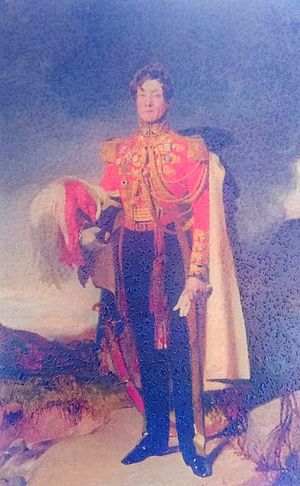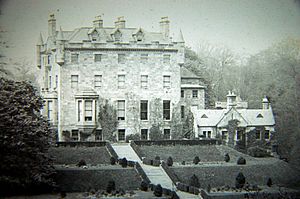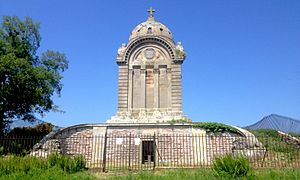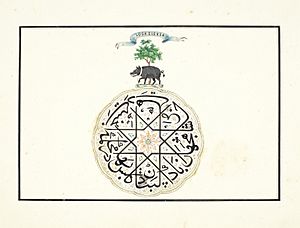Thomas Monteath Douglas facts for kids
Quick facts for kids
Sir Thomas Monteath Douglas
|
|
|---|---|

artist and date unknown
|
|
| Birth name | Thomas Monteath |
| Born | 1787 Hanover Parish, Jamaica |
| Died | October 1868 Stonebyres, Lanarkshire, Scotland |
| Allegiance | |
| Service/ |
Bengal Army |
| Years of service | 1806–1846 |
| Rank | General |
| Unit | 35th Regiment of Bengal Native Infantry |
| Conflicts |
|
| Awards | |
General Sir Thomas Monteath Douglas (1787 – October 1868) was an important officer in the Bengal Army. This army was part of the East India Company, a powerful British trading company. He fought in many wars and campaigns, especially the First Anglo-Afghan War.
Contents
Early Life and Beginnings
Thomas Monteath Douglas was born in 1787 in Hanover Parish, Jamaica. His original name was Thomas Monteath. He later added "Douglas" to his name when he inherited a special family estate.
In 1806, at the age of 19, Thomas joined the East India Company's army. He became an ensign, which is a junior officer rank. He served with the 35th Regiment of Bengal Native Infantry for his entire career.
Military Career
Early Campaigns
Thomas Monteath first saw action in 1809 and 1810 in Bundelkhand, India. He fought under Sir Gabriel Martindell. During these tough campaigns, many forts belonging to local leaders had to be captured. Thomas was wounded twice during these attacks.
He was promoted to lieutenant in 1808. He then served in the Anglo-Nepalese War in 1814 and 1815. He fought in battles like Timlee Pass and Kulinga. He was wounded again during the attack on Srinagar.
Fighting the Marathas
In 1818, Monteath took part in the Third Anglo-Maratha War. This war involved fighting against the Pindaris, who were groups of raiders. His regiment helped to push the raiders back into Central India. This allowed Lord Hastings' army to defeat them.
Monteath also fought in the Marwar Campaign in 1820. He was promoted to captain in 1821. In 1826, he helped capture the city of Bharatpur during a successful siege. He received a medal for his bravery.
Family Life
In 1826, he married Lucinda Florence Whish in Meerut. They had a daughter. Sadly, Lucinda passed away in 1837 in Lucknow.
The First Anglo-Afghan War
Monteath became a major in 1829 and a lieutenant-colonel in 1834. He led his regiment throughout the First Anglo-Afghan War. This war made him famous.
His regiment was part of the force that pushed through the difficult Khyber Pass. They also helped capture Ghazni and Kabul in 1839. For his service, he received a medal and became a Companion of the Order of the Bath. The Afghan ruler, Shah Shujah Durrani, also gave him the new Order of the Dooranee Empire.
After Kabul was captured, Monteath's regiment stayed there as a garrison. In 1841, they were ordered to return to India. However, Afghans rebelled, and Monteath's brigade had to fight their way to Jellalabad. There, they prepared for a long defense.
Monteath played a key role in the famous defense of Jellalabad. His regiment, the 35th Bengal Native Infantry, became good friends with the British 13th Light Infantry during this time. In 1842, the Jellalabad garrison was finally rescued. Monteath then commanded a brigade in the next part of the campaign.
For his brave actions, Monteath was promoted to colonel in 1842. He was also made an aide-de-camp to the Queen. In 1845, he became the colonel of his old regiment before leaving India.
Later Life and Legacy
In 1851, Thomas Monteath inherited the "Douglas Support" estate. This was a special family inheritance, and because of it, he added "Douglas" to his name. He never went back to India.
He continued to be promoted in the army. He became a major-general in 1854, a lieutenant-general in 1856, and a full general in 1865. In 1865, he was also made a Knight Commander of the Order of the Bath for his many years of service.
Sir Thomas Monteath Douglas passed away in October 1868 at Stonebyres in Lanarkshire, Scotland.
Monteath Mausoleum
Near the end of his life, Sir Thomas commissioned the Monteath Mausoleum. This special building was designed by architects Peddie & Kinnear and built in 1864. It is located near Ancrum in Scotland. In 2014, a group started a project to restore the building, which was finished in 2019.
Historical Paintings
In 2013, a collection of 31 paintings by the artist Ghulam Ali Khan was put up for auction. These paintings showed scenes of Delhi and portraits of the last Emperor of Delhi, Bahadur Shah Zafar. They were believed to have been given to "Captain Douglas," who auctioneers think was Sir Thomas Monteath Douglas.




